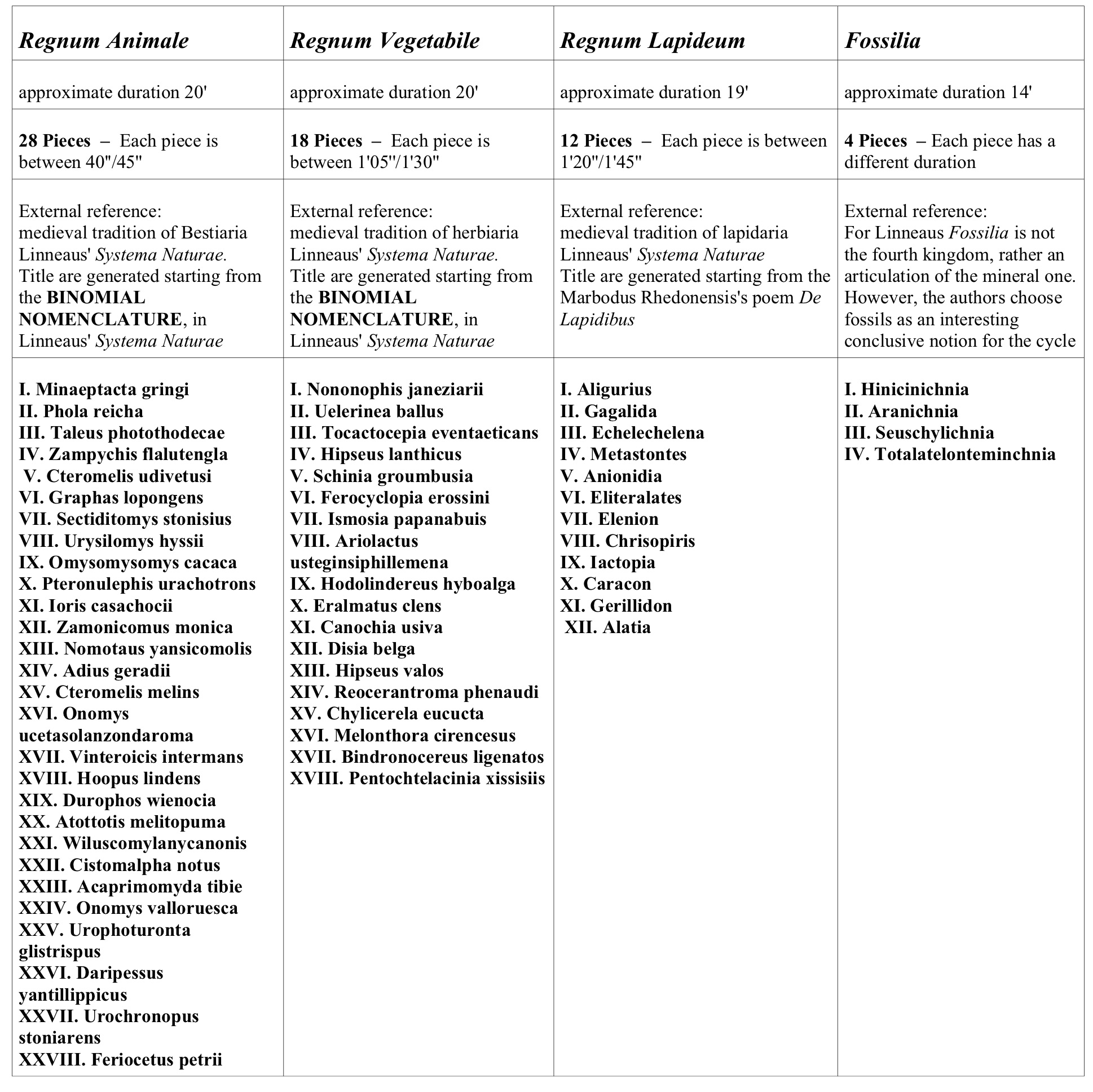APPENDIX 4 - The exploitation of the idea of catalogue in Systema Naturae, by Mauro Lanza and Andrea Valle
Systema Naturae is a complex work, written between 2013 and 2017. It is a four hand composition by Mauro Lanza and Andrea Valle. Though the two Italian composers belong to the same generation, they come from slightly different backgrounds. Andrea Valle (1974) is an electric bass player, who studied composition with Azio Corghi. He is now a researcher at the University of Torino, and many of his projects involve computational control of physical objects, for improvisations, sound installations and multimedia performances. Mauro Lanza (1975) instead, studied piano in Venice and Computer music at IRCAM, and his pieces are now performed by many ensembles for contemporary music. In his compositions, he often seeks to bring together classical instruments with less conventional sound sources (such as toy instruments, noise-makers, physical modelling synthesis). The two composers share a common interest in using less conventional sound sources. In this sense, the peculiarity of Systema Naturae lies in the co-existence of traditional acoustic instruments and different setups of electromechanical devices, made up of what might be called “hacked objects”. Systema Naturae is a cycle of four works, each one dedicated to a different natural kingdom: Regnum Animale, Regnum Vegetabile, Regnum Lapideum and Fossilia. The main reference is to Systema Naturae (1735), the important scientific work by Carl Linnaeus, a Swedish botanist, physician and zoologist, who relied on the classification of nature in three kingdoms — animal, vegetable, and mineral — and introduced the binomial nomenclature, i.e. a formal system of naming living beings by genre and species. The latter could be seen as a rationalistic attempt to order the polymorphic appearance of nature, which is not the case of the other references, represented by the Medieval books of bestiaria, herbaria and lapidaria. These were, in fact, heterogeneous collections of miscellaneous animals, plants and stones, multifaceted catalogues of both existing and fantastic creatures with much information and many illustrations and descriptions. In the cycle Systema Naturae, the concept of the catalogue is quite central and it could be seen as a model thatinforms different aspects of the work: first of all its general organization. Hence each Regnum is structured as a catalogue, made up of a sequence of short pieces, each one dedicated to an imaginary animal, plant, stone, or fossil. From Table.1 is possible to observe the structure of each Regnum. Within the four Regna the number of the pieces decreases, while their length increases progressively: Regnum Animale collects 28 pieces of approximatively 40'' each, Regnum Vegetabile has 18 pieces, with a duration between 1'00'' and 1'40'', Regnum Lapideum has 12 pieces between 1'20'' and 1'45'', and Fossilia has just four pieces, where the longest is about 6'.
Tab.1. Structure of Systema Naturae
In each of the four Regna, traditional ensemble instruments are integrated with a different set of electro-mechanical devices, made of what might be called “hacked objects”. After their creation, all these electro-mechanical devices have been named, classified and grouped in different families, partly following the existing taxonomy defined by Hornbostel and Sachs – which classifies instruments as idiophones, chordophones, aerophones, and electrophones – and partly following other criteria such as time responsivity (which is related to the temporal behaviour of the object and to its capacity to provide a fast attack and a fast delay, to allow complex rhythmical organization), control behaviour (distinction between objects with a discrete behaviour - on/off - or continuous one), presence or absence of pitch, and so on. This classification represents another aspect related to the idea of cataloguing. Moreover, at an early stage of the compositional process, the two composers worked on the creation of a database, in which they collected a large number of recordings of every single electromechanical device and recordings of instrumental sounds – including sounds produced with particular extended techniques –. All recordings have been analysed and catalogued on the basis of their possible dynamics, spectral contents, rhythmic behaviours, and so on. During the compositional process, this database has been exploited to pursue a smart use of the spectral contents of sound in building and combining different sound events. The two composers have systematically used simulations to provide a testing environment, supplying constant feedback on the compositional process. Their shared database has been constantly updated with spectral information, gathered from audio analysis tools, and used to feed algorithmic compositional environments - such as SuperCollider on Andrea Valle's side, and OpenMusic, on Mauro Lanza's side - in which accurate simulations of the pieces were created. In this way, the two composers maintained thorough control over the richness and the complexity of the sound material they were working with.
>> go back to 3.5 The Role of Memory in Storing, Anticipating and Archiving
>> or go to Conclusions
Main References
Fantechi, Daniela. Systema Naturae, by Andrea Valle and Mauro Lanza, experimentation as starting point of a piece of “acoustic computer music” – 2018 – Atti del Convegno “EMS18: Electroacoustic Music: is it still a form of experimental music?” – EMS Network.http://www.ems-network.org/spip.php?article451 (last access 07/03/2022).
Gorelli, Tommaso. I Regnum di Lanza e Valle, (interview), in The New Noise,
06/07/2015. https://www.thenewnoise.it/i-regnum-di-andrea-valle-e-mauro-lanza/(last access 07/03/2022).
Roullier, Pierre et al. Mauro Lanza & Andrea Valle Systema Naturae, Collection A la ligne Ensemble, Champigny sur Marne : 2E2M, 2016.
Valle Andrea. “Residual Orchestras: Notes on low profile, automated sound instruments”, in The virtuous circle design culture and experimentation Proceeding of the cumulus conference, paper presented at Summer Cumulus Conference-Politecnico di Milano 2015, June 3rd, 2015. https://iris.unito.it/retrieve/handle/2318/1547460/104873/cumulus-2015-054Experimenting.pdf (last access 07/03/2022).
Valle, Andrea. “Towards a semiotic of the audible”, in Signata, Annales des Sémiotique, Sémiotique de la musique, edited by Aage Brandt and José Roberto do Carmo Jr. Liege : Presses Universitaire, 6, 2015.
Valle, Andrea. [and Mauro Lanza]. “Systema Naturae: shared practices between physical computing and algorithmic composition”, Sound and Music Computing Conference, July 5-8, Espoo, Finland : 391- 398, 2017.
https://iris.unito.it/retrieve/handle/2318/1645065/351641/SMC17_p391.pdf
(last access 07/03/2022).
